Cameron Enters the Big Picture
|
Read more
at in70mm.com The 70mm Newsletter |
| Written by: William Kallay | Date: May 20, 2003 |
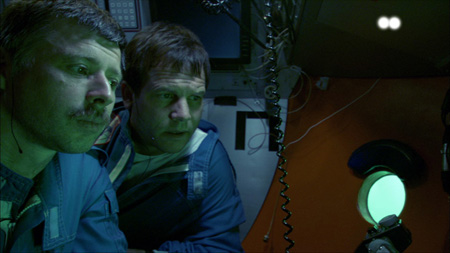 MIR 2 pilot Genya Chernaiev (left) and Bill Paxton
(center) look through a porthole in the submersible to the wreckage on the
deck of Titanic. MIR 2 pilot Genya Chernaiev (left) and Bill Paxton
(center) look through a porthole in the submersible to the wreckage on the
deck of Titanic.Proving once again that James Cameron hasn’t met a seemingly impossible challenge he didn’t like, the writer/director spoke to a crowd of LFCA members about his high definition 3D film, "Ghosts of the Abyss". The normally “tough” audience of large format filmmakers, exhibitors and other delegates gathered in Los Angeles to hear Cameron give his keynote address. He is one of the few high profile commercial directors to enter the realm of large format filmmaking. Not that Cameron or his film seemed to ruffle feathers within the LFCA. Both were greeted with a warm reception. With the likes of Cameron, Disney and Warner Bros. releasing films in the large format, and with digital filmmaking making inroads into large format, one has to wonder what sort of changes are in store for the industry. |
Further
in 70mm reading: in70mm.com's IMAX Page Internet link: |
Ghosts of the Abyss |
|
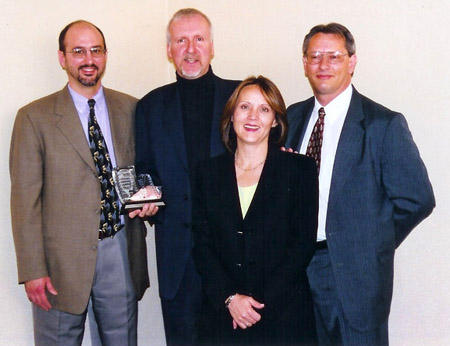 From left-to-right: Robert Dennis, CFI; Director James
Cameron; Charlotte Huggins, NWAVE Pictures; Paul Holliman, Buena Vista
Film Dist. From left-to-right: Robert Dennis, CFI; Director James
Cameron; Charlotte Huggins, NWAVE Pictures; Paul Holliman, Buena Vista
Film Dist.Cameron’s foray into the world of documentary filmmaking is somewhat unusual for a director who has helmed large scale epics like "Terminator 2: Judgment Day" (1991) and "Titanic" (1997). But Cameron has bent the envelope more times than not. The director shot Ghosts in high definition video, bypassing the large format world’s preferred method of shooting in 15-perf 70mm. Digital technology, such as CGI and digital film processing, has been used in the large format industry. But rarely has HD, let alone 3D HD, been used in conjunction with a movie for large format release. The director and his crew used a “Reality Cam,” which is a modified Sony HD 24p camera with Panavision lenses. Over 300 hours of footage was recorded and then edited into a 60-minute film. “I want to shoot everything in 3D,” said Cameron. “The camera system is pretty easy to use. Now that we’ve seen that the camera can do almost anything it needs to do, I want to shoot features in the same camera format.” The film was not run through IMAX’s Digital Re-Mastering (DMR) process, according to Cameron, because it would’ve been cost prohibitive, for the budget was around $12.5 million. “If you’ve got a $100 million feature and you want to put it out on a 100 IMAX screens, I think it’s worth spending the money.” In the case of "Ghosts", the HD footage was scanned directly out to large format film. Cameron did, however, reveal plans that there is a possibility that "Titanic" could receive DMR treatment. |
|
Director of Photography Rodney Taylor Saluted |
|
Rodney Taylor was given the 5th Annual Kodak Vision Award for his work in
large format cinematography, presented by writer Ray Zone. Taylor’s
resume includes "Alaska: Spirit of the Wild" (1997), "Amazing Journeys"
(1999), "All Access" (2001), "Ultimate X" (2002) and most recently,
"Our
Country" (2003).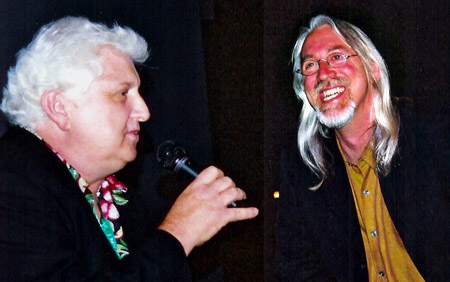 Writer Ray Zone and
D.P. Rodney Taylor Writer Ray Zone and
D.P. Rodney Taylor"It is a very big honor to be in the same company as David Douglas, Reed Smoot, Sean Phillips, and Noel Archambault, the past recipients. These are cinematographers that I have learned a lot from over the last 13 years and I have loved watching their images. This is also a tribute to the directors that I have been very lucky to collaborate with. I am very lucky that I get to shoot large format films," said Taylor in an interview after the conference. Clips of his work were shown on the California Science Center IMAX screen during the award presentation. True to the adventuresome work that goes into shooting many large format films, Taylor has been around the world. Wild bears in Alaska, wildfires in the American wilderness and riding along with X Gamers in a street luge race hasn’t stopped Taylor from getting great shots. |
|
Changes Afoot |
|
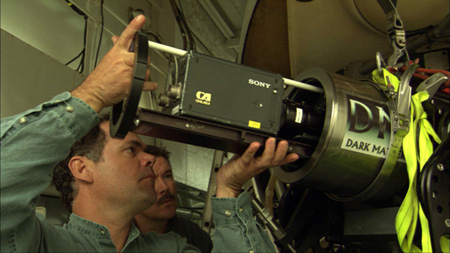 A crew member (left) prepares the unique camera
as Mike Cameron (center) looks on. A crew member (left) prepares the unique camera
as Mike Cameron (center) looks on.Digital. The buzzword was used frequently during the course of the LFCA conference. Consider that "Ghosts of the Abyss" was shot in HD. Consider that a few more 35mm features have been earmarked for IMAX’s Digital Re-mastering process (DMR). Consider that Disney’s recent animated films were converted to large format from digital files. Consider that digital image correction was used in the 3D film, "Bugs!" (2003) to align images. And consider that Olympus has introduced its prototype Super High Definition (SHD) 4K resolution camera, which was used for large format tests done at Imagica U.S.A. Digital is no longer a buzzword in the large format industry, but more of a reality. For the past few years at the LFCA conference, there have been some HD-to-IMAX and 5-perf 70mm tests performed. In the so-called early days of the demonstrations, some of the HD footage looked good, but some didn’t due to the technology not being ready for primetime. Even at last year’s conference, some HD-to-IMAX footage drew laughs in comparison to 15/70 originated material. But how things can change. Hardly anyone commented on either "Ghosts of the Abyss"’ use of digital cinematography or the Olympus SHD demo in negative light. Both presented an alternative to large format photography. The cameras are lightweight and fairly adaptive to rigorous environments. It is notable that a number of formats have been used in large format films, and most audiences probably haven’t noticed it. Almost every type of visual medium has been used from old-time photographs to broadcast video. Is this to say that large format’s days are numbered? Not at all. It seems that filmmakers in this industry prefer to use 15/70 or 8/70 cameras for their projects. But their range of using different tools has increased. |
|
Film Festival |
|
|
This year’s LFCA conference included a number of large format showings.
Unlike in past years, there wasn’t a special 5-perf 70mm presentation or
a revival of This Is Cinerama. Most of the films shown were traditional
IMAX documentaries, with a few shorts thrown in. Those films included "Ghosts of the
Abyss"; "Legend of the Forest-Special Edition"; "Ocean
Wonderland 3D"; "Straight Up! Helicopters in Action";
"Bugs! 3D"; "India-Kingdom
of the Tiger"; "Texas: The Big Picture"; shorts "Falling in Love
Again", "Home
of Freedom" & "Where the Trains Used to Go";
"Our Country"; "Adrenaline Rush": "The Science of
Risk"; "Pulse: a STOMP Odyssey" and "Coral Reef
Adventure". "The film Bugs! 3D" (2003) won Best Feature Film and the short, "Where the Trains Used To Go", won Best Short at the LFCA Annual Gala Dinner. |
|
Size Matters, Even In DMR |
|
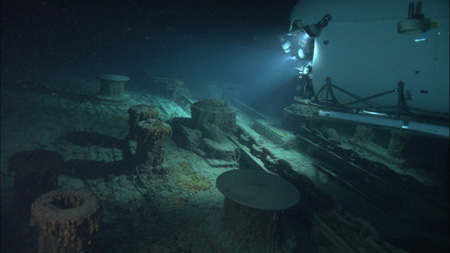 MIR at Titanic MIR at TitanicThough I wasn’t able to attend one of the sessions, “Re-purposing Film for Large Format Presentation,” IMAX’s re-mastering efforts have given the large format industry a small imprint on the commercial side of the movie business. DMR is a computer program that can digitally blow-up 35mm or HD footage into the 15/70. Grain is significantly reduced and the overall picture quality is quite good. Box office has been mixed on the DMR versions of Hollywood productions. "Apollo 13: The IMAX Experience" was a financial disappointment, while "Star Wars: Attack of the Clones-The IMAX Experience" drew a little over $7 million (source-LF Examiner/cinergetics.com). In the scale of big time Hollywood fare, this kind of draw is nothing special. But for a film that earned over $200 million in North America during its regular engagement, and was critically dismissed, those aren’t bad numbers. It is possible that the re-mastered versions of "The Matrix Reloaded" and "The Matrix Revolutions" in 15/70 could perform strongly at the box office. With the built-in audience awareness of the Matrix series and with Warner Bros.’ marketing power, a successful run in large format could bring more commercial fare to the IMAX screen on a day-and-date basis. |
|
Conclusions About LFCA 2003 |
|
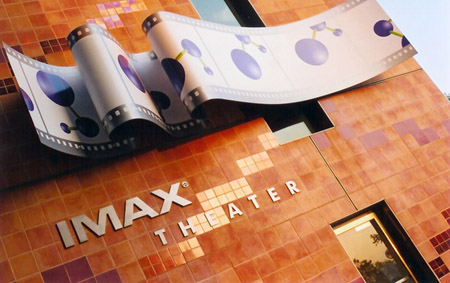 The California Science Center in Los Angeles The California Science Center in Los AngelesThis year’s conference wasn’t so much about commercial versus institutional large format filmmaking and distribution, as it has been in the past. It was a combination of factors. One of the most successful directors in Hollywood has released a film in large format. Digital cinematography is being used in select projects. And some commercial films are being released with DMR prints, rather than in “enhanced 35mm” in large format cinemas. What does this mean for the large format industry? Will commercial filmmaking dominate venues in which large format documentaries reign? Will digital technology replace traditional large format photography? Of course, it’s difficult to predict what changes will occur. But changes are in the air. |
|
|
Go: back
- top - back issues
- news index Updated 22-01-25 |
|
